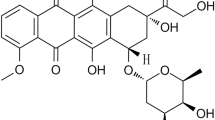Abstract
The cytotoxic and antitumour activities of five organotin complexes (1–5) with o-hydroxy-benzoic or p-hydroxy-benzoic acids were evaluated in a series of in vitro and in vivo experiments. All complexes exhibited strong cytotoxic activity against all cancer cells lines, whereas complexes 1, 2 and 4 induced apoptosis at significantly lower doses than complexes 3 and 5. Human cancer cells treated with increasing concentrations of complexes 1, 2 and 4 gradually lost their ability to form colonies. Only complexes 1 and 2 inhibited colony formation efficiency in rat leiomyosarcoma cells. Histopathology of liver and kidney showed mild damage and lung oedema after a single injection of 10 mg/kg body wt of complex 1 to Wistar rats. At higher doses (100 mg/kg body wt) brain stem oedema was observed. Daily administration of tumour-bearing Wistar rats (leiomyosarcoma) with 1 mg/kg body wt of complex 1 until death reduced the mean tumour growth rate by more than 3× fold and prolonged mean survival time by 120%. These findings indicate that the organotin complexes with ortho- or para-hydroxy-benzoic acids possess potent cytotoxic and antitumour activity and they could be used as potential chemotherapeutic agents.






Similar content being viewed by others
References
Abdellah MA, Hadjikakou SK, Hadjiliadis N, Kubicki M, Bakas T, Kourkoumelis N, Simos YV, Karkabounas S, Barsan MM, Butler IS (2009) Synthesis, characterization, and biological studies of organotin(IV) derivatives with o- or p-hydroxybenzoic acids. Bioinorg Chem Appl 2009:542979
Alama A, Tasso B, Novelli F, Sparatore F (2009) Organometallic compounds in oncology: implications of novel organotins as antitumor agents. Drug Discov Today 14:500–508
Amir MK, Khan S, Rehman Z, Shah A, Butler IS (2014) Anticancer activity of organotin(IV) carboxylates. Inorg Chim Acta 423:14–25
Arjmand F, Parveen S, Tabassum S, Pettinari C (2014) Organo-tin antitumor compounds: Their present status in drug development and future perspectives. Inorg Chim Acta 423:26–37
Avdikos A, Karkabounas S, Metsios A, Kostoula O, Havelas K, Binolis J, Verginadis I, Hatziaivazis G, Simos I, Evangelou A (2007) Anticancer effects on leiomyosarcoma-bearing Wistar rats after electromagnetic radiation of resonantradiofrequencies. Hell J Nucl Med 10:95–101
Aw TY, Nicotera P, Manzo L, Orrenius S (1990) Tributiltin stimulates apoptosis in rats thymocytes. Arch Biochem Biophys 283:46–50
Boyer IJ (1989) Toxicity of dibutyltin, tributyltin and other organotin compounds to humans and to experimental animals. Toxicology 55:253–298
Cai J, Wang M, Li B, Wang C, Chen Y, Zuo Z (2009) Apoptotic and necrotic action mechanisms of trimethyltin in human hepatoma G2 (HepG2) cells. Chem Res Toxicol 22:1582–1587
Chasapis CT, Hadjikakou SK, Garoufis A, Hadjiliads N, Bakas T, Kubicki M, Ming Y (2004) Organotin(IV) derivatives of L-cysteine and their in vitro anti-tumor properties. Bioinorg Chem Appl 2004:43–54
Dokorou V, Primikiri A, Kovala-Demertzi D (2011) The triphenyltin(VI) complexes of NSAIDs and derivatives. Synthesis, crystal structure and antiproliferative activity. Potent anticancer agents. J Inorg Biochem 105:195–201
Garbutcheon-Singh KB, Grant MP, Harper BW, Krause-Heuer AM, Manohar M, Orkey N, Aldrich-Wright JR (2011) Transition metal based anticancer drugs. Curr Top Med Chem 11:521–542
Gielen M (1995) Tin-based antitumour drugs: new developments. Met Based Drugs 2:99–103
Gielen M, de Vos D, Meriem A, Boualam M, el Khloufi A, Willem R (1993) The acute toxicity and in vivo antitumour activity against L1210 leukemia of triphenyltin 3,5-diisopropylsalicylate, bis (di-n-butyl-(s)-2-pyrrolidone-5-carboxylato)tin oxide and di-n-butyltin bis(3-amino-4-methylbenzoate). Vivo 7:171–174
Grondin M, Marion M, Denizeau F, Averill-Bates DA (2007) Tributyltin induces apoptotic signaling in hepatocytes through pathways involving the endoplasmic reticulum and mitochondria. Toxicol Appl Pharmacol 222:57–68
Höti N, Ma J, Tabassum S, Wang Y, Wu M (2003) Triphenyl tin benzimidazolethiol, a novel antitumor agent, induces mitochondrial-mediated apoptosis in human cervical cancer cells via suppression of HPV-18 encoded E6. J Biochem 134:521–528
Köberle B, Tomicic MT, Usanova S, Kaina B (2010) Cisplatin resistance: preclinical findings and clinical implications. Biochim Biophys Acta 1806:172–182
Liu HG, Wang Y, Lian L, Xu LH (2006) Tributiltin induces DNA damage as well as oxidative damage in rats. Environ Toxicol 21:166–171
Matsuno-Yagi A, Hatefi Y (1993) Studies on the mechanism of oxidative phosphorylation. ATP synthesis by submitochondrial particles inhibited at F0 by venturicidin and organotin compounds. J Biol Chem 268:6168–6173
Metsios A, Verginadis I, Simos Y, Batistatou A, Peschos D, Ragos V, Vezyraki P, Evangelou A, Karkabounas S (2012) Cytotoxic and anticancer effects of the triorganotin compound [(C6H5)3Sn(cmbzt)]: an in vitro, ex vivo and in vivo study. Eur J Pharm Sci 47:490–496
Miller RO, Tadagavadi RK, Ramesh G, Reeves WB (2010) Mechanisms of cisplatin nephrotoxicity. Toxins (Basel) 2(11):2490–2518
Muhammad N, Guo Z (2014) Metal-based anticancer chemotherapeutic agents. Curr Opin Chem Biol 19:144–153
Nakatsu Y, Kotake Y, Ohta S (2007) Concentration dependence of the mechanisms of tributyltin-induced apoptosis. Toxicol Sci 97:438–447
Reader S, Moutardier V, Denizeau F (1999) Tributyltin triggers apoptosis in trout hepatocytes: the role of Ca2+, protein kinase C and proteases. Biochim Biophys Acta 1448:473–485
Ross M, Gielen M, Lelieveld P, De Vos D (1991) Cytotoxic activity of di-n-butyltin(IV)(X-A-B-Y) compounds related to salicylic acid against human tumour cells. Anticancer Res 11:1089–1091
Tada-Oikawa S, Kato T, Kuribayashi K, Nishino K, Murata M, Kawanishi S (2008) Critical role of hydrogen peroxide in the differential susceptibility of Th1 and Th2 cells to tributyltin-induced apoptosis. Biochem Pharmacol 75:552–561
Verginadis II, Karkabounas S, Simos Y, Kontargiris E, Hadjikakou SK, Batistatou A, Evangelou A, Charalabopoulos K (2011) Anticancer and cytotoxic effects of a triorganotin compound with 2-mercapto-nicotinic acid in malignant cell lines and tumor bearing Wistar rats. Eur J Pharm Sci 42:253–261
Viviani B, Rossi AD, Chow SC, Nicotera P (1995) Organotin compounds induce calcium overload and apoptosis in PC12 cells. Neurotoxicology 16:19–25
Winship KA (1988) Toxicity of tin and its compounds. Advers Drug React Acute Poison Rev 7:19–38
Author information
Authors and Affiliations
Corresponding authors
Ethics declarations
Conflict of interest
The authors declare that they have no conflict of interest.
Rights and permissions
About this article
Cite this article
Agiorgiti, M.S., Evangelou, A., Vezyraki, P. et al. Cytotoxic effect, antitumour activity and toxicity of organotin derivatives with ortho- or para-hydroxy-benzoic acids. Med Chem Res 27, 1122–1130 (2018). https://doi.org/10.1007/s00044-018-2135-7
Received:
Accepted:
Published:
Issue Date:
DOI: https://doi.org/10.1007/s00044-018-2135-7




